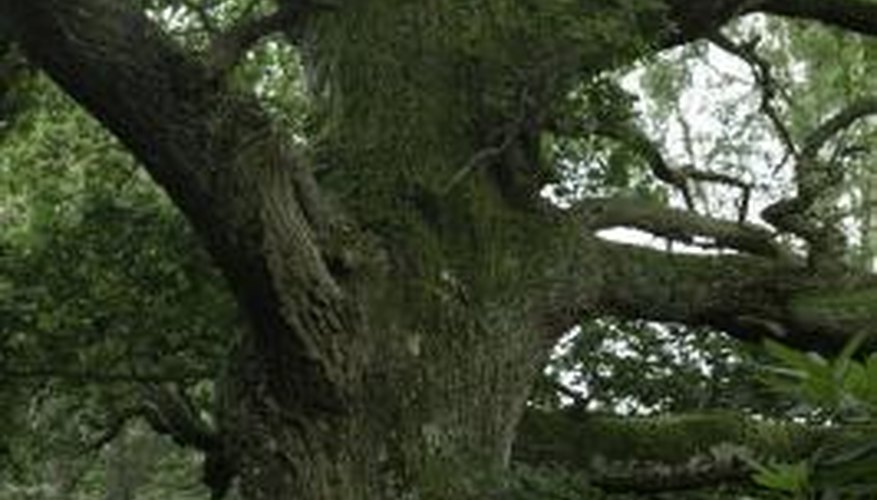Deciduous trees, oaks can exist in nutrient poor locations, low light and periods of drought. The tree's adaptability makes it a survivor. The tree quickly regrows in areas suffering substantial wildfires. Its ability to rapidly resprout gives it an advantage because it rapidly colonises an area to become the dominant tree species.
Fire
Fire kills the top growth of seedlings and saplings, but within one year after the fire, the oak tree's roots form new seedlings. After a fire, oak tree seedlings grow rapidly. A large oak tree often appears dead for a year or two, but new growth eventually appears. The tree's thick bark shields it from fire. Acorns buried beneath the soil's surface also withstand a fire and sprout.
- Fire kills the top growth of seedlings and saplings, but within one year after the fire, the oak tree's roots form new seedlings.
Root System
Oak trees create a deep taproot in search of water. The depth of the tree's taproot allows it to withstand periods of drought. The bur oak produces a taproot exceeding 5 feet in depth during the first year. Acorns produce excessive root growth before establishing top growth. The oak tree's lateral root system spreads out as far as 90 feet from the tree's trunk. The extensive lateral roots help stabilise the tree in high winds. Oaks usually produce most of their lateral roots in the top 3 feet of the soil. The oak tree adapted itself to grow in shallow soil by producing roots that grow only 1 foot below the soil's surface.
- Oak trees create a deep taproot in search of water.
- The oak tree adapted itself to grow in shallow soil by producing roots that grow only 1 foot below the soil's surface.
Irrigation and Fertilizer
Oak trees rarely require irrigation. They withstand long, hot summers with no water. The trees benefit from slowly watering the root system for 24 hours once or twice per summer season. Oak trees do not tolerate excessively wet soil conditions well and develop root collar rot. The tree flourishes in nutrient-poor soil and does not require fertiliser applications. The leaves break down in time and provide the oak with valuable natural nutrients.
- Oak trees rarely require irrigation.
- Oak trees do not tolerate excessively wet soil conditions well and develop root collar rot.
Acorns
Oak trees produce abundant acorn crops every 2 to 4 years. The Minnesota Department of Natural Resources suggests a lack of abundant acorn crops some years may be the tree's survival strategy. The lack of abundant acorns helps to cull seed-eating mammals, such as squirrels. The lack of seedeaters helps the oak's acorns germinate successfully into seedlings. Acorns begin germinating immediately after they fall from the tree in the late fall to early winter months. Red oak tree acorns overwinter before germination begins in the early spring. Approximately 75 to 95 per cent of the acorns will successfully germinate.
- Oak trees produce abundant acorn crops every 2 to 4 years.
- Acorns begin germinating immediately after they fall from the tree in the late fall to early winter months.
